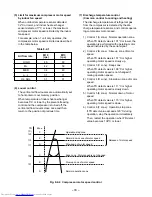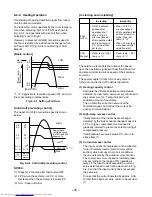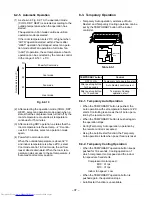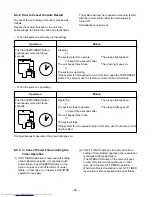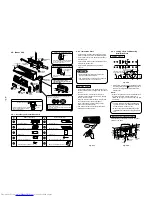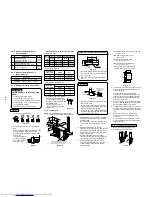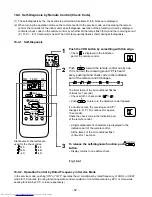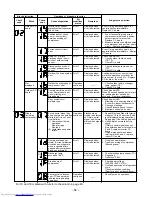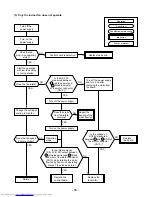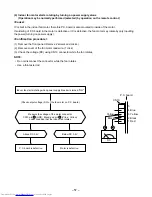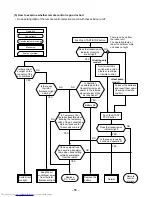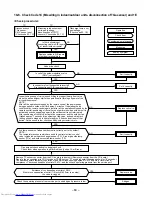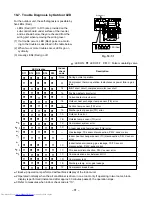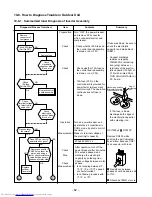
– 47 –
Half union
Flare nut
Externally
threaded side
Internally
threaded side
Use a wrench to secure.
Use a torque wrench to tighten.
Outdoor unit
Indoor unit
B
B UNIT
ø6,35
ø9,52
A
A UNIT
ø6,35
ø9,52
Flare at
indoor
unit side
Flare at
outdoor
unit side
Tightening connection
Align the centers of the connecting pipes and
tighten the flare nut as far as possible with your
fingers. Then tighten the nut with a spanner and
torque wrench as shown in the figure.
CAUTION
• Do not apply excess torque. Otherwise,
the nut may crack depending on the
conditions.
(Unit : N·m)
• Tightening torque of flare pipe connections
Pressure of R410A becomes higher than that
of R22. (Approx. 1,6 times) Therefore, using a
torque wrench, tighten firmly the flare pipe
connecting sections which connect the indoor
and outdoor units up to the specified
tightening torque. Incorrect connections may
cause not only a gas leakage,
but also a trouble of the refrigeration cycle.
9-3-8. Evacuating
After the piping has been connected to all indoor
unit(s), you can perform the air purge together at
once.
AIR PURGE
Evacuate the air in the connecting pipes and
in the indoor unit using vacuum pump.
Do not use the refrigerant in the outdoor unit.
For details, see the manual of vacuum pump.
Use a vacuum pump
Be sure to use a vacuum pump with counter-flow
prevention function so that inside oil of the pump
does not flow backward into pipes of the air
conditioner when the pump stops. (If inside oil of
the vacuum pump enters into the air conditioner
which adopts R410A, a trouble of the refrigeration
cycle may be caused.)
1. Connect the charge hose from the manifold
valve to the service port of the gas side
packed valve.
2. Connect the charge hose to the port of
vacuum pump.
3. Open fully the low pressure side handle of the
gauge manifold valve.
4. Operate the vacuum pump to start for
evacuating.
Perform evacuating for about 15 minutes if the
total piping length is 30 meters. (15 minutes
for 30 meters) (assuming a pump capacity of
27 liters per minute.)
Then confirm that the pressure gauge reading
is –101 kPa ( –76 cmHg).
5. Close the low pressure side valve handle of
gauge manifold.
6. Open fully the valve stem of the packed
valves (both side of Gas and Liquid).
7. Remove the charging hose from the service
port.
8. Securely tighten the caps on the packed valves.
9. Execute above works from 1 to 8 on the each
connected indoor unit.
Packed valve handling precautions
• Open the valve stem all the way out; so not try
to open it beyond the stopper.
• Securely tighten the valve stem cap torque is
as follows :
Compound pressure gauge
Pressure gauge
Manifold valve
Handle Hi
(Keep full closed)
Charge hose
(For R410A only)
Vacuum pump adapter
for counter-flow prevention
(For R410A only)
Packed valve at liquid side
Packed valve at gas side
Service port
(Valve core (Setting pin))
Connecting
pipe
Handle Lo
Charge hose
(For R410A only)
–101kPa (–76cmHg)
Vacuum
pump
Gas side
(ø12,7 mm)
Gas side
(ø9,52 mm)
Liquid side
(ø6,35 mm)
Service port
50 to 62 N•m
(5,0 to 6,2 kgf•m)
33 to 42 N•m
(3,3 to 4,2 kgf•m)
14 to 18 N•m
(1,4 to 1,8 kgf•m)
14 to 18 N•m
(1,4 to 1,8 kgf•m)
Fig. 9-3-13
9-3-9. Electrical Work
For the air conditioner that has no power cord,
connect a power cord to it as mentioned below.
5mm
Terminal block
(Connecting cable)
Terminal block
(Power supply)
Connecting cable
(B unit)
Connecting cable
(A unit)
Cord clamp
Screw
Power cord
Earth line
Outer dia. of copper pipe
ø6,35 mm
ø9,52 mm
ø12,7 mm
Tightening torque
14 to 18 (1,4 to 1,8 kgf•m)
33 to 42 (3,3 to 4,2 kgf•m)
50 to 62 (5,0 to 6,2 kgf•m)
Fig. 9-3-10
Never apply refrigerating machine oil to
the flare surface.
Fig. 9-3-11
Fig. 9-3-12
Hexagon wrench is required.
Power
source
220–230–240
Single phase
50 Hz
Maximum
running
current
8,5 A
Fuse
rating
10A
Power
cord
2,0mm
2
(AWG-14)
or more
Fig. 9-3-14
How to wiring connection
1. Connect the connecting cable to the terminal
as identified with their respective matched
numbers on the terminal block of indoor and
outdoor unit. (1,0 mm
2
AWG 18 or more)
2. When connecting the connecting cable to the
outdoor unit terminal, prevent water coming in
the outdoor unit.
3. Insulate the unused cords (conductors) with
strip the sheath of connecting cable with PVC
tape.
Process them so that they do not touch any
electrical or metal parts.
4. For inter-unit wiring, do not use a cut wire
jointed to another on the way.
Use wires long enough to cover the entire
length.
CAUTION
• Wrong wiring connection may cause some
electrical parts burn out.
• Be sure to use the cord clamps specified
positions with attached to the product.
• Do not damage or scratch the conductive
core and inner insulator of power and inter-
connecting cables when peeling them.
• Be sure to comply with local codes on
running the wire from outdoor unit to indoor
unit (size of wire and wiring method etc.)
• Use the power cord and Inter-connecting
cable with specified thickness, specified
type, and protective devices specified.
Stripping length power cord and
connecting cable
Connecting
cable
Power cord
Earth line
Earth line
10
10
L N
30
10
30
40
10
40
1 2 3
Fig. 9-3-15

